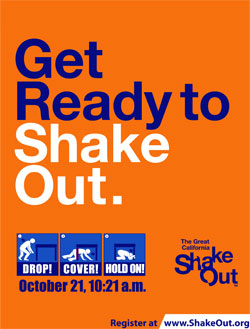
Drop, cover and hold on means sinking to the ground, covering the head and neck with one’s arms and taking cover under a heavy table or desk.
Barring cover, “just dropping to the ground and staying in one spot or moving next to an interior wall will help to protect you,” Dengler said.
Millions of Californians are expected to take part in the annual drill on Thurs., Oct. 21. Almost seven million residents practiced drop, cover and hold on last year, and well over six million, including nearly 40,000 residents of Humboldt, Del Norte and Mendocino Counties, have signed up at http://www.ShakeOut.org for the 2010 exercise. Registration remains open until the eve of the exercise.
A major goal of state disaster preparedness officials is the development of an entrenched culture of earthquake and tsunami readiness to minimize losses and hasten recovery.
“What each of us does in our homes, schools, and offices, and what we do together as communities and as a state, will determine whether California’s next major earthquake will be a natural disaster from which we recover quickly or a major catastrophe that affects our way of life for many years,” Dengler said.
State and county officials urge everyone to secure the contents of their homes and offices, organize emergency supplies and update family emergency plans in preparation for the ShakeOut.
Last January’s magnitude 6.5 earthquake on the North Coast was a reminder that the region is prime earthquake country, Dengler cautioned. In the aftermath, she and her students documented that a scant 12% of Humboldt County residents dropped, covered and held on. Some 22% made the mistake of walking or running outside and 25% mistakenly headed for doorways. Both actions are fraught with risk.
“The most dangerous place to be during an earthquake is the interface between indoors and outdoors,” warned Dengler, who has been part of six post-event reconnaissance teams at earthquake sites around the world. “Doorways are no stronger than the rest of modern buildings and people can be injured by swinging doors or people rushing to escape outside. Participation in the ShakeOut drill is important for people to develop the muscle memory to do the right thing when the next earthquake strikes.”
Details of what to do are at http://www.dropcoverholdon.org. Regional information for Northern California is posted at http://www.humboldt.edu/shakyground/.
Last year, Northern California residents from Mendocino County north to Oregon and east to Nevada received copies of the latest edition of “Living on Shaky Ground: How to Survive Earthquakes and Tsunamis in Northern California.
The 32-page, full-color guide contains the latest information about regional earthquake and tsunami hazards. It presents a seven-step plan of action for readiness and mitigation before, during and after earthquakes. The Humboldt Earthquake Education Center at Humboldt State and a host of state and federal agencies based the booklet on the latest scientific, engineering and sociological research. It is written in easy prose and thoroughly illustrated to make its points clear.
One of the most important aspects of the ShakeOut drill and the booklet is the opportunity they provide to generate discussion, culminating in action, said Dengler, who led the preparation of “Living on Shaky Ground.”
She explained, “One of the main things to come out of sociological research is that, before people act, they need to talk things through, a process that sociologists call ‘milling.’ People are more likely to store food and water, secure their bookshelves and write up a family preparedness plan if they’ve discussed it among themselves first. When you’re ready ahead of time, you greatly increase your chances of saving yourself and your family, reducing your losses and helping your community recover faster.”
Dengler underscores that reliance on the government is not enough. “The government is there to assist afterwards, but the definition of a disaster is that normal emergency services are completely overwhelmed,” she said. “The only way you’re going to get help is to be prepared yourself. This is a personal, a neighborhood and a community responsibility.”
The Humboldt Earthquake Education Center, which distributes educational materials such as “Living on Shaky Ground” to schools, the press and the public, is a non-profit unit established in 1985 within HSU’s Department of Geology. The center operates the Humboldt Earthquake Hotline (707/826-6020), a recorded message updated daily about local, regional and worldwide activity. The center also conducts intensity studies of regional earthquakes.
The ShakeOut Web site is http://www.shakeout.org. The Humboldt Earthquake Education Center is at http://humboldt.edu/shakyground and also can be reached at 707/826-6019.